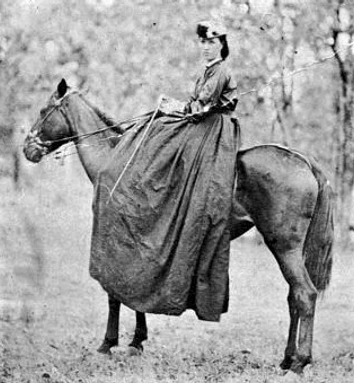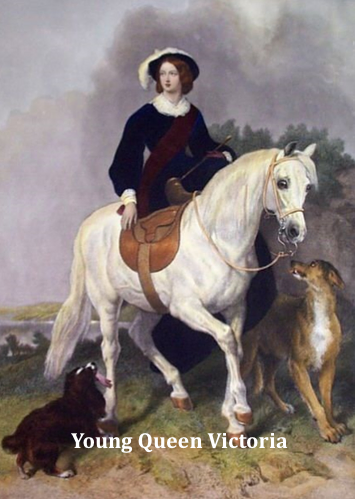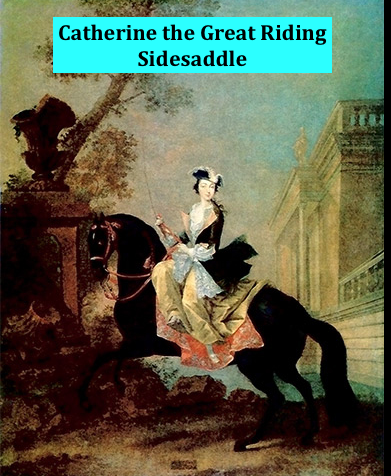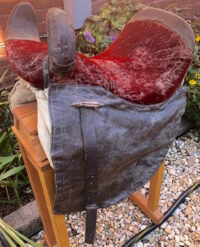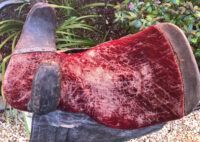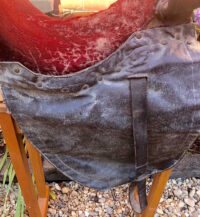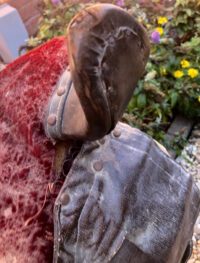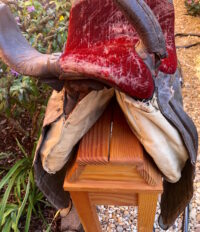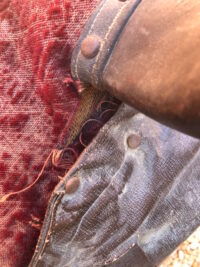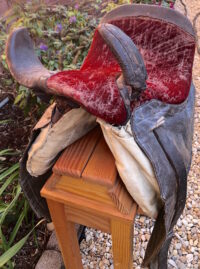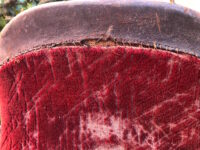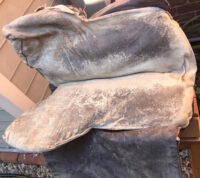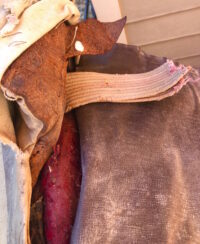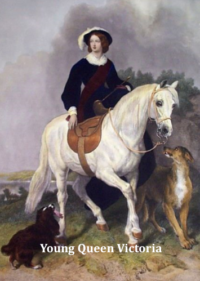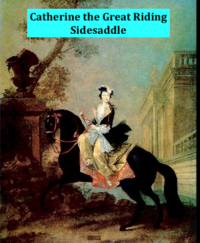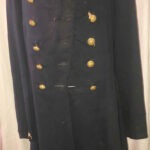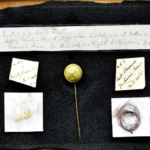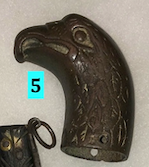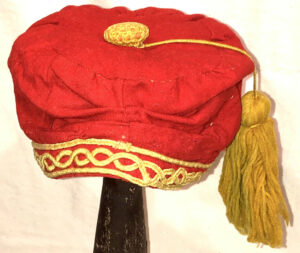Fine C.1830 – 1850 Side Saddle
$300
Fine C.1830 – 1850 Side Saddle – These rarely encountered, antebellum side saddles have always been difficult to find; this example remains in overall very fine condition, with some minor seam openings. This saddle exhibits the second, curved pommel, for the left leg of the rider, found in saddles that post-date 1835. The leather covering of the two pommels is finished in a decorative stitching pattern; the seat is covered with a burgundy colored, carpeting material, comparable to the carpet material utilized to construct carpetbags during the antebellum and bellum eras. The padding on the underside of the saddle is constructed an off white, canvas or coarse weave cotton; it remains completely intact and in good condition. Both original, leather skirts remain in place and are in great, flexible condition. A remnant of the original, heavy cotton girth remains, beneath the seat. Finally, both original stirrup straps, with their original roller buckle adjustments, remain in place, although there are no stirrups – we can obtain period, iron stirrups and supply them to the buyer for a minor additional cost. This is a rare saddle, found in the Valley of Virginia.
Sidesaddle riding is a form of equestrianism that uses a type of saddle which allows a rider (usually female) to sit aside rather than astride an equine. Sitting aside dates back to antiquity and developed in European countries in the Middle Ages as a way for women in skirts to ride a horse in a modest fashion while also wearing fine clothing. It has retained a specialty niche even in the modern world.
History
The earliest depictions of women riding with both legs on the same side of the horse can be seen in Greek vases, sculptures, and Celtic stones. Medieval depictions show women seated aside with the horse being led by a man, or seated on a small padded seat (a pillion) behind a male rider. Ninth century depictions show a small footrest, or planchette added to the pillion.[1] These designs did not allow a woman to control a horse; she could only be a passenger.
In Europe, the sidesaddle developed in part because of cultural norms which considered it unbecoming for a woman to straddle a horse while riding. This was initially conceived as a way to protect the hymen of aristocratic girls, and thus the appearance of their being virgins.[2][3] Further, long skirts were the usual fashion and riding astride in such attire was often impractical, awkward, and could be viewed as immodest. However, women did ride horses and needed to be able to control their own horses, so there was a need for a saddle designed to allow control of the horse and modesty for the rider.
The earliest functional “sidesaddle” was credited to Anne of Bohemia (1366–1394).[4] It was a chair-like affair where the woman sat sideways on the horse with her feet on a small footrest. The design made it difficult for a woman to both stay on and use the reins to control the horse, so the animal was usually led by another rider, sitting astride. The insecure design of the early sidesaddle also contributed to the popularity of the Palfrey, a smaller horse with smooth ambling gaits, as a suitable mount for women.
A more practical design, developed in the 16th century, has been attributed to Catherine de’ Medici. In her design, the rider sat facing forward, hooking her right leg around the pommel of the saddle with a horn added to the near side of the saddle to secure the rider’s right knee. The footrest was replaced with a “slipper stirrup“, a leather-covered stirrup iron into which the rider’s left foot was placed.[1] This saddle allowed the rider both to stay on and to control her own horse, at least at slower speeds.
However, not all women adopted the sidesaddle at all times. Women such as Diane de Poitiers (mistress to Henry II of France) and Marie Antoinette were known to ride astride. Catherine the Great of Russia went so far as to commission a portrait showing her riding astride wearing a male officer’s uniform.[5]
Mrs. Esther Stace riding sidesaddle and clearing 1.98 m (6 ft 6 in) at the Sydney Royal Easter Show, 1915, a feat made possible because of the leaping horn.
Two pommel design
An antique two pommel sidesaddle.
In the 1830s, Jules Pellier invented a sidesaddle design with a second, lower pommel to the sidesaddle. In this design, still in use today, one pommel is nearly vertical, mounted approximately 10 degrees left of top dead center and curved gently to the right and up. The rider’s right leg goes around the upright, or fixed pommel, which supports the right thigh of the rider when it is lying across the top center of the saddle. The lower right leg rests along the shoulder of the left (near) side of the horse and up against the second pommel (called the leaping head or leaping horn) which lies below the first on the left of the saddle. It is mounted about 20 degrees off the top of the saddle. This pommel is curved gently downward in order to curve over the top of the rider’s left thigh, and is attached in a manner so that it can pivot slightly, to adjust to the individual rider. The rider places her left leg beneath this pommel, with the top of the thigh close or lightly touching it, and places her left foot in a single stirrup on that side.
The impact of the second pommel was revolutionary; the additional horn gave women both increased security and additional freedom of movement when riding sidesaddle, which allowed them to stay on at a gallop and even to jump fences while fox hunting and show jumping. With this design, nearly all recreational equestrian pursuits were opened to women, yet they could also conform to expectations of modesty. For example, a world record in sidesaddle show jumping was set at 6 ft 6 in (1.98 m) at a horse show in Sydney, Australia in 1915.[6] The leaping horn was the last major technological innovation for the sidesaddle and remains the core of basic design even for saddles of contemporary manufacture made with modern materials.
Prior to 1835, a side saddle had one or two pommels; one turned up to support the right leg, some with a second pommel which turned down over the left leg.
“Sidesaddle History”. georgialadiesaside.com. Georgia Ladies Aside. Archived from the original on 2007-10-09.
“The Agricultural Society of NSW, “Country Leader”, 6 Nov 1989″. Archived from the original on 5 December 2008. Retrieved 20 November2008.

















